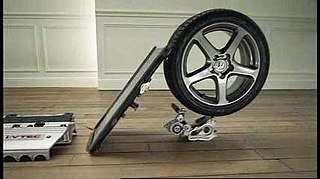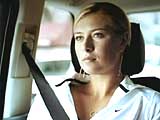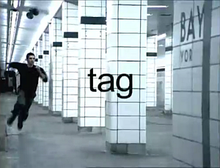
"Cog" is a British television and cinema advertisement launched by Honda in 2003 to promote the seventh-generation Accord line of cars. It follows the convention of a Rube Goldberg machine, utilizing a chain of colliding parts taken from a disassembled Accord. Wieden+Kennedy developed a £6 million marketing campaign around "Cog" and its partner pieces, "Sense" and "Everyday", broadcast later in the year. The piece itself was produced on a budget of £1 million by Partizan Midi-Minuit. Antoine Bardou-Jacquet directed the seven-month production, contracting The Mill to handle post-production. The 120-second final cut of "Cog" was broadcast on British television on 6 April 2003, during a commercial break in ITV's coverage of the 2003 Brazilian Grand Prix.
BBDO is a worldwide advertising agency network, with its headquarters in New York City. The agency originated in 1891 with the George Batten Company, and in 1928, through a merger with Barton, Durstine & Osborn (BDO), the agency became Batten, Barton, Durstine & Osborn. With more than 15,000 employees at 289 offices in 81 countries, it is the largest of three global networks of agencies in the portfolio of Omnicom Group.
"Bo Knows" was an advertising campaign for Nike cross-training shoes that ran in 1989 and 1990 and featured professional baseball and American football player Bo Jackson. It was also used as an advertising campaign for EA Sports’ Madden 22.

Wieden+Kennedy is an American independent global advertising agency best known for its work for Nike. Founded by Dan Wieden and David Kennedy, and headquartered in Portland, Oregon, it is one of the largest independently owned advertising agencies in the world.
dom&nic is the working name of directors Nic Goffey and Dominic Hawley. They have been directing music videos and commercials since 1994.

Dan Gordon Wieden was an American advertising executive who co-founded ad firm Wieden+Kennedy. A native of Oregon, he coined the Nike tagline "Just Do It."
Deutsch NY, formerly Deutsch Inc. is an American ad agency headquartered in New York City. The agency was founded by David Deutsch in 1969 as David Deutsch Associates, Inc. In 1989, the company name changed to Deutsch Inc. when Deutsch's son, Donny Deutsch, took over the agency.

R/GA is an innovation consultancy, and digital design and advertising agency, headquartered in New York City, with global offices in Austin, Los Angeles, San Francisco, Portland, London, Berlin, São Paulo, Buenos Aires, Singapore, Shanghai, Sydney and Tokyo. The company has received a number of industry honors for its creative and media work, including Adweek's Digital Agency of the Decade in 2009 and Campaign Magazine's Digital Innovation Agency of the Decade in 2019. R/GA is a subsidiary of Interpublic Group of Companies.
Grrr is an 2004 advertising campaign launched by Honda to promote its newly launched i-CTDi diesel engines in the United Kingdom. The campaign, which centred on a 90-second television and cinema advert, also comprised newspaper and magazine advertisements, radio commercials, free distributed merchandise, and an internet presence which included an online game, e-mail advertising, and an interactive website. The campaign was created and managed by the advertising agency Wieden+Kennedy (W+K). W+K were given a budget of £600,000 for production of the television commercial, a process which lasted six months. The piece was written by Sean Thompson, Michael Russoff and Richard Russell. It was directed by Adam Foulkes and Alan Smith, produced by London-based production company Nexus Productions, and featured American author Garrison Keillor singing the campaign's theme song. Grrr premiered on British cinema screens on September 24, 2004.

Pretty is a television advertisement launched in 2006 by Nike, Inc. to promote its "Nike Women" brand of sportswear. The 60-second spot was handled by advertising agency Wieden+Kennedy in Portland, Oregon. The advert stars Russian tennis player Maria Sharapova in her first appearance as a spokesperson for the brand. Pretty debuted on U.S. television on August 20, 2006, with later appearances in cinemas and in print advertisements. It was directed by Czech director Ivan Zachariáš, with post-production and VFX work by The Mill.
Mountain is a 2003 television and cinema advertisement launched by Sony Corporation to promote the PlayStation 2 video game console. The budget for production and advertising space purchases for the 60-second piece amounted to £5m across all markets. The commercial depicts a Brazilian crowd congregating to form a mountain of human bodies, all competing to reach the top of the pile. The campaign surrounding Mountain was handled by advertising agency TBWA London. The commercial was directed by Frank Budgen. Production was contracted to Gorgeous Enterprises, with post-production by The Mill. Mountain premiered in 30 countries on 13 November 2003.

Smell Like a Man, Man is a television advertising campaign in the United States created by ad agency Wieden+Kennedy for the Old Spice brand of male grooming products, owned by Procter & Gamble. The campaign is commonly referred to as The Man Your Man Could Smell Like, the title of the campaign's initial 30-second commercial. The campaign was launched to market Old Spice's Red Zone After Hours Body Wash, but was subsequently expanded to include other products, following its success. The campaign targets female viewers, despite the product's intended market being male, as the company determined that women frequently make purchasing decisions for hygiene products even for male household members.
Write the Future is an advert made by Nike football for the 2010 World Cup and directed by Mexican filmmaker Alejandro González Iñárritu for the UK based production company, Independent Films Limited. The full version is over three minutes in length and features football players Didier Drogba, Fabio Cannavaro, Wayne Rooney, Franck Ribéry, Ronaldinho, and Cristiano Ronaldo as its main players. All of the players play in a scenario during a World Cup match and after significant events occur, the players usually see a significant ripple effect outside the world of football. The advert aired during the 2010 FIFA World Cup. It features the song "Hocus Pocus", by progressive rock band Focus. It was created by Wieden+Kennedy and written by Mark Bernath, Eric Quennoy, Stuart Harkness and Freddie Powell. The Sound design and mix was done by Raja Sehgal working out of Grand Central Recording Studios in London. The advertisement won the Film Grand Prix at the 2011 Cannes Lions festival.

Lamp is a television and cinema advertisement released in September 2002 to promote the IKEA chain of furniture stores in the United States. The 60-second commercial was the first part of the "Unböring" campaign conceived by advertising agency Crispin Porter + Bogusky, and follows a lamp abandoned by its owner. It was produced by the production company Morton/Jankel/Zander, and was directed by Spike Jonze. Post-production and editing was handled by Spot Welders and sound design by the California-based MIT Out Sound. The commercial aired concurrently with another IKEA piece in the same vein, titled Moo Cow. Lamp, and its associated campaign, was a popular, critical, and financial success. Sales of IKEA furniture increased by eight percent during the period in which the commercial ran, and Lamp received a number of awards, including a Grand Clio and the Grand Prix at the Cannes Lions International Advertising Festival, considered the most prestigious accolade granted by the advertising community.

The Life, also known as We Are ODST, is a television and cinema advertisement launched in 2009 by Microsoft to promote the first-person shooter Halo 3: ODST in the United States. The 150-second piece follows a young soldier through enlistment, training, and battle as an Orbital Drop Shock Trooper (ODST), analogous to a paratrooper that drops from space to a battlefield. The Life was created by advertising agency T.A.G., an offshoot of McCann Erickson. Production of the commercial itself was handled by production company Morton/Jankel/Zander (MJZ). It was directed by Rupert Sanders, and post-production was conducted by Asylum. It was filmed in Hungary, just outside Budapest in a coal mine and abandoned factories to give the sequence an "Eastern Bloc" aesthetic. The commercial and its associated campaign proved hugely successful; on the week of its launch, Halo 3: ODST became the top-selling game for the Xbox 360 worldwide, and over 2.5 million copies were sold within the first few weeks of release. The Life went on to win a number of honours from the advertising and entertainment industries, including two Clio Awards, a London International Advertising Award and several honours from the Cannes Lions International Advertising Festival, the most prestigious awards ceremony in the advertising industry.
Frank Budgen was a British commercial director and co-founder of Gorgeous Enterprises, a London-based film production company. He was voted as the Directors Guild of America commercial director of the year in 2007. His notable works include Tag and Mountain.

"Second Generation" is a 2006 television advertisement introducing Nike's Air Jordan XXI brand of basketball shoes. The ad depicts signature moves from Michael Jordan's NBA career, recreated in the present day by twelve young basketball players around the world. Included are moments from the 1989, 1991, 1992, and 1998 NBA playoffs and the iconic 1988 slam dunk.
Nike Women's Advertising is Nike advertisements towards women.
BETC is a French advertising agency founded in Paris in 1995. The name of the company stands for Babinet, Erra and Tong Cuong, the founding members.
"Champagne" was a television and cinema advertisement launched by Microsoft and created by Bartle Bogle Hegarty. Released in March 2002, the commercial aired in Europe to promote the European release for Xbox. However, after the advertisement received 136 complaints, the commercial was banned on 4 June 2002.









